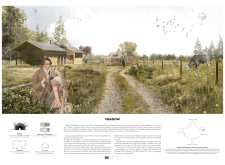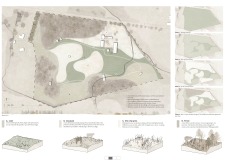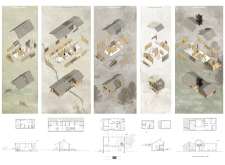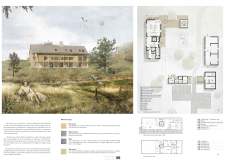5 key facts about this project
This project serves multiple functions, primarily focusing on providing communal and private spaces that enhance community interaction while respecting individual privacy. The architectural design includes diverse areas such as common courtyards, which foster social connections, and private huts, each tailored for various accommodations. This arrangement not only encourages social engagement but also allows residents to retreat into serene private environments, effectively balancing communal life with personal space.
Central to the project is the idea of landscape integration. The design illustrates a commitment to the local topography and natural ecosystem, seamlessly blending architectural elements with the existing flora and fauna. The architect's choices in materiality, particularly the use of locally sourced pine wood and durable natural stone, further emphasize sustainability and environmental connection. These materials are selected not just for their physical properties but also for their aesthetic resonance, evoking a sense of place that aligns with the surrounding landscape.
The spaces within the project are organized in a way that reflects their intended use while enhancing the usability of each area. The design incorporates various zones, such as grasslands for grazing, landscaped lawns for social gathering, and agricultural areas that contribute to the local ecosystem. These elements collectively foster biodiversity, making the project not only a site for human habitation but also a sanctuary for local wildlife.
Furthermore, the unique approach to design includes the implementation of passive solar principles. Roof overhangs and strategic window placements are incorporated to optimize natural light, reducing dependency on artificial lighting and minimizing energy consumption. The use of wood wool insulation further aligns with the sustainable ethos, helping to create an energy-efficient environment conducive to year-round comfort.
The project distinguishes itself through its holistic architectural approach, balancing the aesthetic and functional aspects of design while prioritizing environmental stewardship. By leveraging locally sourced materials and responding compassionately to the existing landscape, the architecture becomes an extension of its surroundings rather than an intrusion.
For those interested in delving deeper into this architectural exploration, further investigation of the project presentation is encouraged. Engaging with elements such as architectural plans, sections, and designs will provide a comprehensive understanding of the innovative ideas and strategies that inform this thoughtful project. Exploring these aspects will illuminate the careful considerations that shape not only this project but can also inspire similar architectural endeavors that aim for sustainability and integration with nature.


























